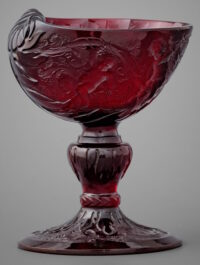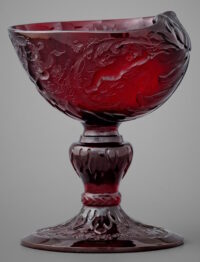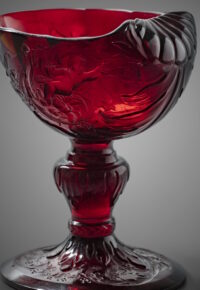 A unique shell-shaped gold ruby red glass drinking cup by 17th century German alchemist, apothecary and glassmaker Johann Kunckel has been acquired by the Rijksmuseum. The deep, intense color of the red was produced by the addition of gold to the glass, a method and recipe pioneered by Kunckel. It dates to around 1685, Kunckel’s first decade as glassmaker to the court of Frederick William I, Elector of Brandenburg. Only about 20 of Kunckel’s early gold ruby red glass pieces are known, and the shape, style and engraving of this calyx cup is unique among them.
A unique shell-shaped gold ruby red glass drinking cup by 17th century German alchemist, apothecary and glassmaker Johann Kunckel has been acquired by the Rijksmuseum. The deep, intense color of the red was produced by the addition of gold to the glass, a method and recipe pioneered by Kunckel. It dates to around 1685, Kunckel’s first decade as glassmaker to the court of Frederick William I, Elector of Brandenburg. Only about 20 of Kunckel’s early gold ruby red glass pieces are known, and the shape, style and engraving of this calyx cup is unique among them.
The chalice is engraved with a scene of putti frolicking around vines. The engraving is attributed to the master glass engraver Gottfried Spiller (1663-1728) who engraved several gold ruby glasses. The glass is processed in such a way that it does not look like blown glass, but is more reminiscent of cut stone. This object therefore fits in with the tradition of the Kunstkammer, collections where wonderful objects from nature, science and art were brought together.
 The fact that gold compounds add to glass could produce shades of red was known in antiquity. German alchemist Andreas Libavius wrote in his seminal text Alchemia in 1597 that dissolved gold created a red tincture that could be used to make “red crystal.” The first modern treatise on glass, written by Antonio Neri of Florence in 1612, also noted that gold can make red glass, but neither the ancient texts nor the later chemistry books included any information about the process or even a basic recipe.
The fact that gold compounds add to glass could produce shades of red was known in antiquity. German alchemist Andreas Libavius wrote in his seminal text Alchemia in 1597 that dissolved gold created a red tincture that could be used to make “red crystal.” The first modern treatise on glass, written by Antonio Neri of Florence in 1612, also noted that gold can make red glass, but neither the ancient texts nor the later chemistry books included any information about the process or even a basic recipe.
The first person to record a functional method for obtaining ruby red glass was Bavarian chemist Johann Rudolph Glauber who in 1659 wrote that gold could be dissolved in a solution of a tin compound and hydrochloric acid. The gold would then precipitate from the solution as a purple powder later dubbed Purple of Cassius that could be added to glass to make it red.
 Glauber’s experiments never delved into the making of the ruby glass itself. It was Johann Knuckel who as both an alchemist and a glass-maker, refined the recipe and process to create gold ruby glassware. He published a treatise of his own on glass production and taught practical chemistry at the University of Wittenberg. In 1678, Prince Frederick William I, Elector of Brandenburg and Duke of Prussia, set Knuckel up on a secluded island near Potsdam with a glass-making factory where he could experiment and perfect his gold ruby glass production away from the prying eyes of competitors.
Glauber’s experiments never delved into the making of the ruby glass itself. It was Johann Knuckel who as both an alchemist and a glass-maker, refined the recipe and process to create gold ruby glassware. He published a treatise of his own on glass production and taught practical chemistry at the University of Wittenberg. In 1678, Prince Frederick William I, Elector of Brandenburg and Duke of Prussia, set Knuckel up on a secluded island near Potsdam with a glass-making factory where he could experiment and perfect his gold ruby glass production away from the prying eyes of competitors.
 His was immensely successful and the glowing dark red glass he made was believed to be a new precious material, not just mere glass. Like rubies themselves, Knuckel’s gold ruby glass was thought to have health benefits particularly for illnesses of the blood. His work launched a fashion for ruby red glass at the end of the 17th century. Every sovereign and ruler at every court in Europe vied to own a gold ruby vessel, including the King of Sweden who poached the master away from the Elector in 1693 and gave him a noble title and estate. Johann von Löwenstern-Kunckel died in 1703 and the heyday of the ruby glass fad died with him.
His was immensely successful and the glowing dark red glass he made was believed to be a new precious material, not just mere glass. Like rubies themselves, Knuckel’s gold ruby glass was thought to have health benefits particularly for illnesses of the blood. His work launched a fashion for ruby red glass at the end of the 17th century. Every sovereign and ruler at every court in Europe vied to own a gold ruby vessel, including the King of Sweden who poached the master away from the Elector in 1693 and gave him a noble title and estate. Johann von Löwenstern-Kunckel died in 1703 and the heyday of the ruby glass fad died with him.